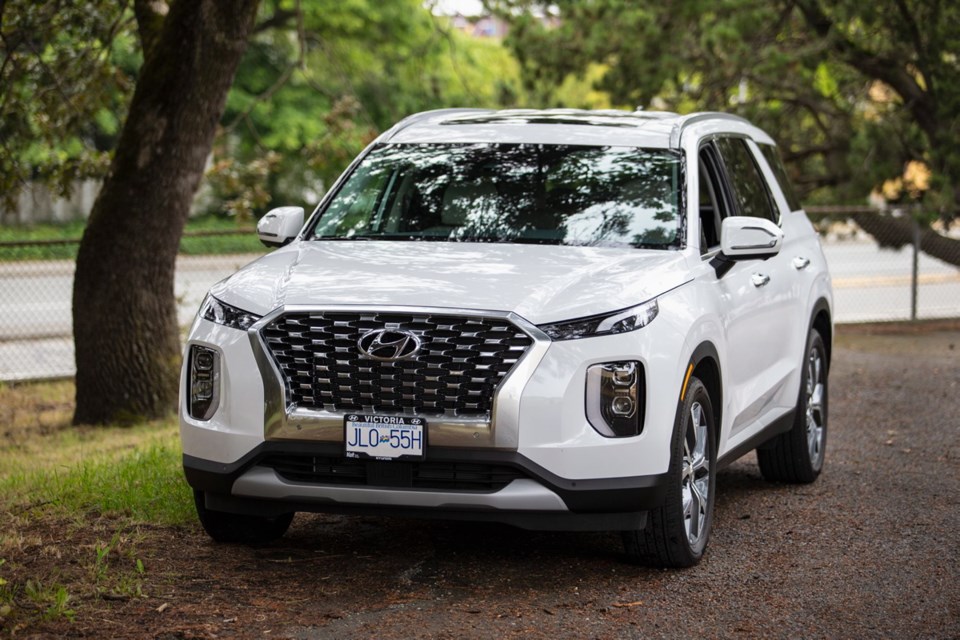If you believe that good things come to those who wait, then the wait for the 2020 Hyundai Palisade, the company’s newest three-row SUV, is finally over.
Up until now, Hyundai buyers looking for a mid-sized SUV with seating for up to eight occupants had to settle for the XL model of the existing Santa Fe.
Hyundai, wisely, saw this as an opportunity to carve out a niche market by taking the Palisade more up-market into the near-luxury segment.
Boy, did they hit that one on the head.
While the Santa Fe XL did offer third-row seating, that real estate wasn’t something that adults could endure for any stretch of time. That’s all changed with ample legroom and headroom now for the rearmost passengers.
Instead of following the Santa Fe in styling, Hyundai tore a page from some luxury manufacturers, endowing the Palisade with a distinctive grille and a style that speaks of its luxury intentions.
While it will be compared with the Volkswagen Atlas, Toyota Highlander or Honda Pilot in price, the up-market stance lets it punch above its weight on looks alone.
The Palisade is offered in four trim levels, starting at $38,499 for the front-wheel-drive Essential. My ride was the top-of-the-line Ultimate model, with a list price of $53,000.
What is interesting is that you can order a front-wheel-drive Palisade in sa���ʴ�ý. Most manufacturers give our neighbours to the south that option, due to the fact that snow in many southern U.S. states is unheard of. But in sa���ʴ�ý, most manufacturers just skip that, equipping all the models in all-wheel drive automatically.
You can add AWD in the base model for an extra $2,000.
There is only one engine, a naturally aspirated 3.8-litre V-6 with 291 horsepower and 262 pound-feet of torque. It is mated to an eight-speed automatic and, in all except the base model, all-wheel drive.
The Palisade gives the driver control with terrain control modes — for sand, mud or snow — along with the usual comfort, eco, smart and sport drive modes.
It also boasts an available auto-levelling rear suspension, handy when carrying heavy loads or towing a heavy camper, for example.
Fit and finish in the interior, especially at this price range, is eye-opening. My Ultimate model checked off all the right boxes, with quilted Nappa leather, a 26-centimetre touchscreen for the infotainment centre, heated and cooled front and second row seats, three-zone climate control, a dual-panel sunroof, power folding third-row seats and more.
My only demerit point is for the faux woodgrain dash, which looks fake. Other manufacturers have managed to even put texture on their fake wood to give it more authenticity.
Despite putting soft surfaces on many places, there are still a number of areas where hard plastic remains.
The Palisade is loaded with technology and active safety features. Of note is a blind-spot collision-avoidance-assist system, which applies brake power on the opposite tire to help avoid a collision.
If you are conscientious and turn on your indicator before attempting to change lanes, the Palisade rewards you with an image of the lane (from cameras mounted on the side mirrors) projected on your instrument screen.
Hyundai’s safe-exit-assist system, which temporarily locks the rear doors when it senses a vehicle approaching from behind, is a godsend for cyclists.
Equally welcome is Hyundai’s rear-occupant alert with ultrasonic sensors, which will warn of precious cargo being left behind unintentionally.
Hyundai is serious about it. The first warning appears on the dash after the vehicle is turned off. If the vehicle is locked, the sensors will monitor for movement in the rear seats and flash the lights and sound the horn. If the driver has an active BlueLink subscription, the vehicle will send a text message to the assigned smartphone to notify him or her of the warning. Hats off to you, Hyundai.
Other notable electronic features to aid families with children is an in-vehicle intercom to converse with the occupants in the rearmost seats and a quiet mode to turn off the rear speakers.
My tester had the 360-degree camera system, with front, rear and curb-side views.
There is also a sensor aimed at the driver. If it senses driver fatigue, it will issue a visible and audio alert, and suggest you take a break.
With sedans on the decline, the SUV has become the avenue for carmakers to go up-market. The Hyundai Palisade has become the new flagship of the Hyundai line.
It is a well-thought-out vehicle, hitting all the highlights as to what a near-luxury buyer is looking for.
For its first foray in the segment, Hyundai has hit the ball out of the park.
THE SPEC SHEET
Type: Mid-sized SUV, front engine, all-wheel-drive
Engine: 3.8-litre V-6, 291 hp at 6,000 r.p.m., 262 lb.-ft. of torque at 5,200 r.p.m.
Transmission: Eight-speed automatic
Dimensions (mm): Length, 4,980; width, 1,975; height, 1,750; wheelbase, 2,900
Curb weight (kg): 2,022
Price (base/as tested): $53,999/$56,009 (includes $1,910 freight and PDI and $100 AC tax)
Options: Nil
Tires: 245/50 R20 all-season on alloy wheels
Fuel type: Regular
Fuel economy (L/100km): 12.3 city/ 9.6 highway
Warranty: Five years/100,000 km new car



